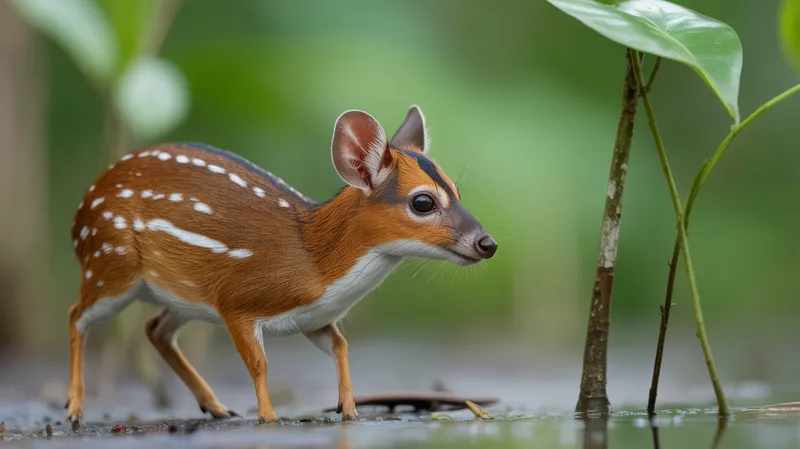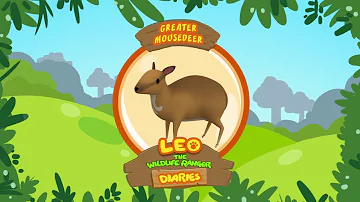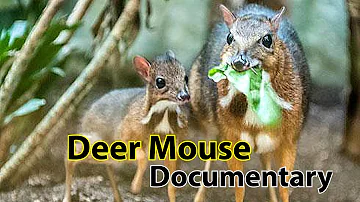
Greater Mouse-deer
Tragulus napu

Meet the Greater Mouse-deer
The Greater Mouse-deer, also known as the Napu, is a small, shy ungulate native to the dense lowland forests of Southeast Asia. Despite its name, it is neither a true deer nor a mouse, but a member of the unique family Tragulidae known as chevrotains. This nocturnal species has a delicate, slender body, elongated legs, and a pointed face, allowing it to move silently among thick undergrowth. Males possess small, sharp canine teeth instead of antlers, which they use for territorial disputes. The Greater Mouse-deer is solitary and elusive, making it difficult to observe in the wild.
Classification
Mammal
Habitat
Tropical lowland forests, mangroves, and swampy areas
Diet
Herbivore
Lifespan
10-12 years
Conservation
Least Concern
Weight
5-8 kg
📖Fascinating Facts
Tiny Ungulate
The Greater Mouse-deer is one of the world’s smallest hoofed mammals, standing just 30-35 cm tall at the shoulder.
Nocturnal Lifestyle
This animal is primarily nocturnal, spending its nights foraging for fruits, leaves, and shoots on the forest floor.
Good Swimmer
Greater Mouse-deer are adept swimmers and will cross streams or take to water to evade predators.
📋Detailed Description
The Greater Mouse-deer (Tragulus napu) is the largest member of the Tragulidae family, with adults typically weighing between 5 and 8 kg and measuring 70–75 cm in head-body length, with a shoulder height of about 30–35 cm. Its body is compact and slender, with a short tail (5–8 cm), elongated, thin legs, and a pointed, narrow head. The pelage is generally a warm brown with a paler underside, and a distinctive white or buff throat patch that may extend in stripes down the chest. Unlike true deer, mouse-deer lack antlers; instead, males possess elongated, sharp upper canines (saber-like tusks) used in intraspecific combat. The eyes are large and laterally placed, enhancing their nocturnal vision. Their hooves are small and delicate, well-adapted for moving quietly through dense undergrowth and soft, muddy substrates. The species is primarily nocturnal and crepuscular, relying on cryptic coloration and stealth to avoid predators. Solitary by nature, individuals maintain overlapping home ranges, marked by scent glands located on the lower jaw and between the toes. The Greater Mouse-deer is highly elusive, rarely seen except by camera traps or during brief, silent foraging bouts in the forest understory.
💡 Did you know?
The Greater Mouse-deer can swim well and often takes to the water to escape predators.
🔬Research & Sources
Wikipedia Summary
The greater mouse-deer, greater Malay chevrotain, or napu is a species of even-toed ungulate in the family Tragulidae found in Sumatra, Borneo, and smaller Malaysian and Indonesian islands, and in southern Myanmar, southern Thailand, and peninsular Malaysia. Its natural habitat is subtropical or tropical, moist, lowland forest.
Last Modified: 5/29/2025
🎭Behavior & Social Structure
Greater Mouse-deer are predominantly solitary and exhibit crepuscular to nocturnal activity patterns, emerging at dusk to forage and retreating to dense cover by dawn. They are highly secretive, moving with deliberate, cautious steps and freezing at the slightest disturbance. Their diet consists mainly of fallen fruits, leaves, shoots, buds, fungi, and occasionally tender roots, making them important seed dispersers in their ecosystems. Foraging is typically done alone, though overlapping feeding territories may result in brief, non-aggressive encounters. Males are territorial, using their tusk-like canines to spar with rivals, though actual fights are rare and usually involve ritualized displays. Scent marking is frequent, with individuals rubbing their mandibular glands on vegetation and using interdigital glands to mark trails. Resting sites are concealed in dense vegetation or under root tangles, and individuals may use the same bedding area repeatedly. Vocalizations are rare, but when alarmed, they may emit a sharp, high-pitched bark or stamp their feet.
👶Reproduction & Life Cycle
The reproductive biology of Tragulus napu is characterized by a polygynous mating system, with males defending territories that overlap with those of several females. Breeding can occur year-round in equatorial regions, though some populations exhibit peaks during the rainy season when food is abundant. Females have a short estrous cycle (about 9–10 days) and can conceive shortly after giving birth, a phenomenon known as postpartum estrus. Gestation lasts approximately 152–155 days (about 5 months), after which a single precocial fawn is born. Neonates are well-developed, able to stand and follow the mother within minutes of birth. Maternal care is minimal; the fawn is hidden in dense cover for several weeks, visited only for nursing, a strategy that reduces predation risk. Weaning occurs at around 2–3 months, and sexual maturity is reached at 5–6 months. Lifespan in the wild is poorly documented but is estimated at 8–10 years.
🛡️Adaptations & Survival
The Greater Mouse-deer exhibits several adaptations for survival in dense, tropical forests. Its small size and slender build allow it to move swiftly and silently through tangled vegetation, while cryptic coloration provides camouflage against the dappled forest floor. The elongated canines of males serve as weapons in territorial disputes, compensating for the absence of antlers. Large eyes and sensitive hearing enhance nocturnal foraging and predator detection. The interdigital and mandibular scent glands are used for communication and territory marking in low-visibility environments. Their digestive system is adapted for a varied herbivorous diet, with a simple, three-chambered stomach (unlike the four-chambered stomach of true ruminants), allowing efficient processing of fibrous plant material and fallen fruits. Behavioral adaptations include freeze-and-flee responses and the use of habitual runways through undergrowth to escape predators.
📚Research Sources
🎨Cultural Significance
In local folklore throughout Southeast Asia, mouse-deer (including Tragulus napu) are often depicted as clever and resourceful tricksters, outwitting larger animals—a theme found in Malay and Indonesian oral traditions (the character 'Sang Kancil' is especially prominent, though not always specifically T. napu). They are sometimes hunted for food, but their small size and elusive nature make them less significant as a game species compared to other ungulates. In some regions, their presence is considered a sign of a healthy, undisturbed forest, and they may feature in traditional ecological knowledge as indicators of environmental integrity. There is little evidence of significant ritual or medicinal use.
🔬Recent Research & Discoveries
Recent research on Tragulus napu has focused on its ecology, population genetics, and role in seed dispersal within Southeast Asian forests. Camera trap studies have improved understanding of its activity patterns and habitat preferences, revealing a strong association with undisturbed primary and mature secondary forests. Genetic studies indicate significant population structuring across island and mainland populations, with implications for conservation management. Ongoing research is investigating the impact of habitat fragmentation on movement and gene flow, as well as the species' resilience to selective logging. There is also interest in the comparative anatomy and evolutionary history of Tragulidae, as mouse-deer represent one of the most basal lineages of ruminant mammals, offering insights into early ungulate evolution.
🎥Wildlife Videos

Greater Mouse-Deer - Leo The Wildlife Ranger Animal Diaries | Animal Facts for Kids
Welcome to another page of Leo's animal diaries! In today's diary, the spotlight is on Greater Mouse-Deer - its name was given ...
Leo the Wildlife Ranger - Official Channel

Chevrotain: The 12 Inch Ungulate
The Chevrotain is the smallest hoofed animal in the world. It also has fangs. Support Animalogic on Patreon: ...
Animalogic

Tiny Mouse Deer with Vampire Fangs!? | The Chevrotain
In today's video, we'll show you one tiny, fanged mammal that's literally “a little of everything.” It's the Chevrotain, known as ...
Blue Orangutan

Singapore's surprising wild life | Filming the elusive Greater Mousedeer | Wild City: Forest Life
The Greater Mousedeer was thought to be extinct from Singapore's forests for 80 years. See what it takes to track down this rare ...
CNA

Secret Forests | David Attenborough's Wild City 4/6 | Go Wild
Here on the fringes of the city, the jungle harbours fascinating species, including many that have never been filmed before.
Go Wild

Deer Mouse documentary - nature's small survivor
Deer Mouse Documentary - Nature's Small Survivor Explore the fascinating world of the Deer Mouse (Peromyscus maniculatus) in ...
Service Ai Video
🌍Habitat Information
The Greater Mouse-deer typically inhabits Tropical lowland forests, mangroves, and swampy areas environments. Greater Mouse-deers have adapted to their environments with specialized features and behaviors.
Primary Habitat:
Tropical lowland forests, mangroves, and swampy areas
More detailed habitat information will be available soon.
🛡️Conservation Status
The Greater Mouse-deer is currently classified as Least Concern. Conservation efforts are crucial for preserving this species for future generations.
Common Threats:
- 🏠Habitat loss and fragmentation
- 🌡️Climate change impacts
- 🎯Hunting and poaching
- 🏭Human-wildlife conflict
⚠️Threats & Conservation Challenges
While classified as Least Concern by the IUCN, the Greater Mouse-deer faces significant threats from habitat loss due to logging, conversion of lowland forests to agriculture (especially oil palm and rubber plantations), and infrastructure development. Fragmentation of habitats isolates populations, increasing vulnerability to local extinction. They are also hunted for bushmeat and occasionally trapped for the pet trade, though less intensively than some larger ungulates. Predators include large snakes, raptors, and carnivorous mammals such as clouded leopards and civets. Population trends are difficult to assess due to the species' secretive habits, but declines have been noted in areas of severe habitat disturbance. Conservation challenges include the lack of comprehensive population surveys and the need for effective protection of remaining lowland forest habitats.
🔬Scientific Classification
Scientific Name
Tragulus napu
Classification Hierarchy
🔍 About Taxonomic Classification
Taxonomic classification is a hierarchical system used by scientists to classify and organize living organisms based on shared characteristics and evolutionary relationships.
The system moves from broad categories (Kingdom) to increasingly specific ones, with each animal's scientific name typically consisting of its Genus and species.
📝Community Notes
Share your observations and insights about the Greater Mouse-deer with our community of wildlife enthusiasts.
Join Our Community
Sign in to share your observations and connect with fellow wildlife enthusiasts.
Sign In to ContributeNo community notes yet
Be the first to share your observations about the Greater Mouse-deer!
Explore Greater Mouse-deer
Select a tab above to learn more about this amazing animal.
📸Photo Gallery
No photos available for this animal yet.
🌟Discover More Wildlife
Continue your journey of discovery with more fascinating animals from our database
